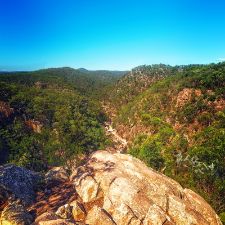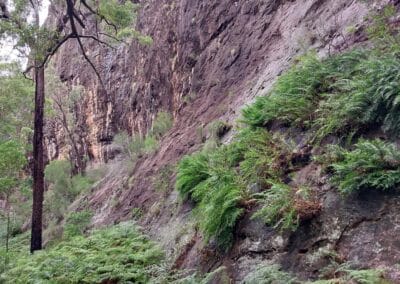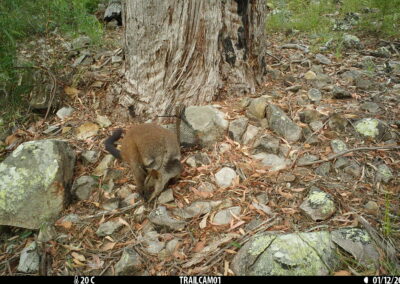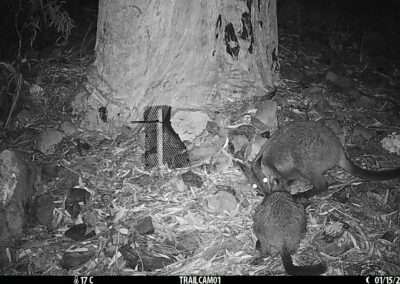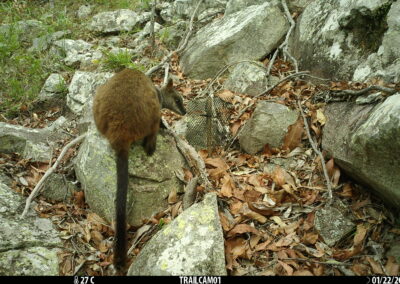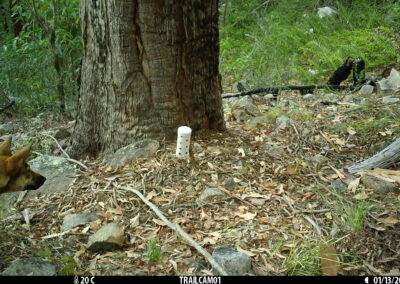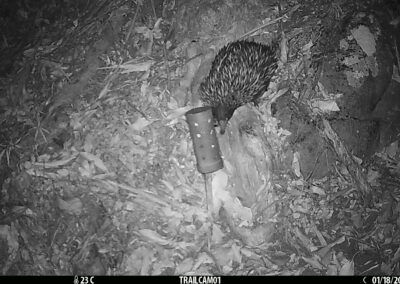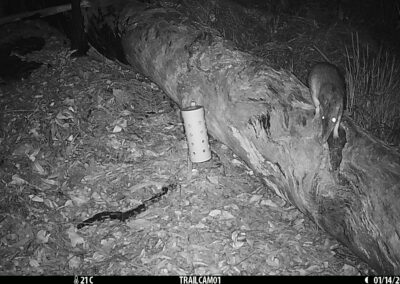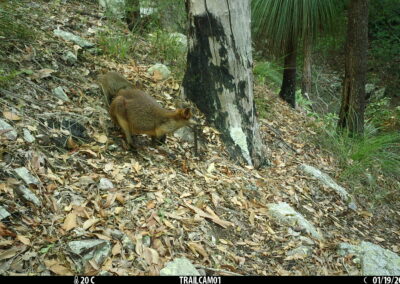Brush-tailed Rock-wallaby Recovery in SEQ
Monitoring, weed and pest management to encourage BTRW populations
Back to BTRW Conservation Network
© Steve Parish Nature Connect
About this project
On-ground action will be undertaken on private properties and local government conservation reserves adjacent to five of the six important Queensland populations of the species, at:
- Moogerah Peaks National Park
- Main Range National Park
- Mount Barney National Park
- Crows Nest National Park
- Flinders Peak Conservation Park
Operating as part of the broader Brush-tailed Rock-Wallaby Conservation Network, this project seeks to:
- protect and enhance brush-tailed rock-wallaby populations at key population sites in South East Queensland
- address and mitigate against several key threatening processes — including predation by the European red fox, predation by the feral cat, and weed invasion — on private properties within the greater project area
- engage local landholders in the management of brush-tailed rock-wallaby habitat on private lands
- develop a brush-tailed rock-wallaby habitat management guide to encourage public and private land managers to conduct species-specific restoration activities for brush-tailed rock-wallabies.
 © Steve Parish Nature Connect
© Steve Parish Nature Connect
Monitoring of populations undertaken as part of this project will form baseline data for an ongoing program that will extend far beyond the life of the current project.
 © VM Jones/Getty Images
© VM Jones/Getty Images
Working closely with landowners and regional natural resource management groups enables us to give practical advice that fosters coexistence with this vulnerable species and prioritises brush-tailed rock-wallaby survival.
Saving the Brush-tailed Rock-wallaby
Saving the Brush-tailed Rock-wallaby: A Landholder’s Guide is designed to assist land managers and property owners in protecting, re-creating and enhancing habitat for the brush-tailed rock-wallaby (Petrogale penicillata).
The FREE guide is available to view as a flipbook and can also be downloaded as a PDF document. Or Email us to request a printed copy.
To view the guide:
- Press the > button to start or click on the pages.
- Use the RIGHT and LEFT arrows to move forward or back.
Project progression
Project Officer Paul Revie has identified properties throughout the chosen project areas for camera monitoring, or where brush-tailed rock-wallabies would benefit from increased management of pests and weeds.
Surveys and habitat assessments will provide a baseline for gauging population numbers of wallabies and their predators and competitors and allow researchers to reliably measure outcomes as the project continues.
Flinders-Goolman CA
The project builds on earlier work conducted in the Flinders–Goolman Conservation Area
Crows Nest NP
Brush-tailed rock-wallabies are known to frequent this park.
Main Range NP
Efforts will focus on known populations that tend to dwell in hilly ‘hide-outs’ along Queensland’s southern section of the Great Dividing Range.
Typical BTRW habitat
Prime ‘brushie’ habitat on the Scenic Rim near Mount Barney, at Gillies Ridge Nature Refuge.
Feral cat
Feral cats are a key threatening process for many species that are unused to introduced predators.
Red fox
Foxes were introduced to Australia as a sport hunting species but have caused considerable damage to numerous small to medium-sized mammal species.
Lantana
Lantana species, which out-compete native forbs and grasses, reduce food sources for brush-tailed rock-wallabies.
Carneys Creek
In January 2023, cameras were set on 4 properties at Carneys Creek in the Scenic Rim. The cameras were left out for 16 to 18 days to monitor brush-tailed rock-wallabies and potential threats (dogs, foxes, cats). Rock-wallabies were recorded on 14 out of 25 cameras, and only low densities of pest animals were observed.
Further planned activities will include pest and weed control and continued monitoring to assess how the wallaby populations benefit from control activities.
Brush-tailed rock-wallaby
Brush-tailed rock-wallabies
Brush-tailed rock-wallaby
Wild dog
Echidna
Long-nosed bandicoot
Swamp wallabies
Ongoing activities
- Community engagement, traditional owner, and landholder collaboration
- Infrared camera monitoring surveys
- Weed management (particularly of Lantana species)
- Pest management (particularly of red fox, feral cat and feral dog)
- Monitoring and recording sighting and population data
We’re thrilled that these funds will help us secure brush-tailed rock-wallaby populations in the northern part of their range and prevent further range contraction. Best of all, this will generate ongoing benefits for brushies, long after the lifetime of the project, through the establishment of the Queensland BTRW Conservation Network and the production of the landholder revegetation guide.
Partners & sponsors
- This project was funded in 2021 by the Australian Government’s Environment Restoration Fund Threatened Species Strategy Action Plan – Priority Species Grants
-
Ipswich City Council
-
Logan City Council
-
Scenic Rim Regional Council
-
Somerset Regional Council
-
Southern Downs Regional Council
-
Toowoomba Regional Council


